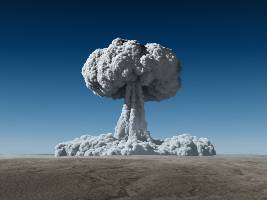Summary
Students examine primary and secondary source documents and photos surrounding the Manhattan Project. Using a close reading strategy, they will highlight and summarize important information found in the documents in their own words. Students will also analyze photos from the Manhattan Project. Students will then create a “newspaper” account with photos of the Manhattan project as if it were a current news story. The newspaper story will serve as the assessment.
Essential Question(s)
What was the Manhattan Project? Is the use or stockpile of nuclear weapons necessary to maintain world peace?
Snapshot
Engage
Students are shown a movie clip of the detonation of a nuclear bomb. They are asked to write down the circumstances when the use of a nuclear bomb upon another country would be appropriate or a necessity or if they believe there is never a justification for the use of an atomic bomb.
Explore
Student groups examine two packets of artifacts about The Manhattan Project and complete a close reading strategy and write a summary from the packet information.
Explain
Based upon their notes and summary, students create a newspaper account with selected photos about the creation of the atomic bomb or of the detonation of the atomic bomb as if it is current news story.
Extend
With the proliferation of nuclear weaponry and warfare, students create a treaty with another "country" of students that defines the terms and use of using nuclear warfare against one another.
Evaluate
The student products can serve as assessments for this lesson. A rubric is provided for the newspaper assessment.
Materials
Nuclear bomb video (Many versions of atomic bomb video clips exist.)
Packet 1 of student materials about the Manhattan Project includes: memo to Americans explaining the dropping of the bomb on Hiroshima by President Truman, leaflet to Japanese people, eyewitness accounts of secret workers working on Manhattan Project.
Packet 2 of student materials includes photos and photo analysis sheet: photo of Fatboy, photo of Hiroshima, 2 photos of Los Alamos
Newspaper article rubric
Computer and internet access for students
Engage
Students watch a video clip of an atomic detonation. Place the question on the board, "Under what circumstances, if any, would you see the use of an atomic bomb as necessary?" Students are asked to write a response on a scrap or half sheet of paper to this question.
Ask students to crumple their piece of paper and toss it into a box. Redistribute wads of paper to other students and call on students to randomly read these anonymous responses. Continue this for a few more rounds so that most or all of the responses are shared aloud. This is a Commit and Toss activity.
Explore
Students are divided into groups of no more than three and receive a packet of materials (primary and secondary source documents) about the Manhattan Project — the project that developed the atomic bomb in secrecy at Los Alamos, NM.
Students groups will first read the primary sources--the first person accounts at Los Alamos, the memo by President Truman to the American people, and the Japanese leaflet, using the close reading strategy, CUS and Discuss.
Student groups create a short summary after each reading and then reflect on what all the documents tell them about the Manhattan Project. Ask student groups to each share out their summary or conclusions about the Manhattan Project.
(Day 2) Student groups will examine the photos and discuss as a team how they support the readings. What does each photo emphasize, point out, or stress? How does the photo contribute to understanding what happened? A photo analysis sheet has been provided in the packet of materials for student groups to complete about the photos.
Explain
To demonstrate their understanding of the significance of the Manhattan Project, its impact, and its effect upon Americans and the Japanese, student groups will create a newspaper account set during the time of the detonation of the bomb. Pass out the newspaper rubric first, discuss expectations from the rubric, and let student groups collaboratively write their "story". These stories can be shared with the class or simply turned in as an assignment. They will be graded with the rubric.
Extend
Regroup students into new working groups. Have students visit the Nuclear Weapons – The Facts or show this link on a projector screen for the class. Other news videos and articles exist about different countries creating nuclear weaponry. To make this assignment current, you may wish to show something from the news currently that is about nuclear weaponry advancement by different countries in addition to the above link.
Based on the information presented on the link, assign one country to each student groups of about 2 to 3. Ask 2 groups with countries of similar nuclear capability and possibly in close proximity to each other to create a treaty that would be beneficial to both countries regarding the use and proliferation of their nuclear warheads. Groups may wish to research their countries’ previous stance on the use and proliferation of nuclear warheads before making a treaty. The treaty should answer the essential question:"Is the use (and stockpile) of nuclear weapons necessary to keep world peace?"
Countries present their treaties and rationales for the treaty requirements to the class.
Evaluate
The student products (group document summaries, photo analysis, the newspaper story, and the treaty presentations) can serve as the assessments for the lesson.
Resources
BOBR. (2013, Apr. 5). Effects of a nuclear bomb [Video]. YouTube. https://www.youtube.com/watch?v=Aza-2wopCFY
K20 Center. (n.d.). Commit and toss. Strategies. https://learn.k20center.ou.edu/strategy/119
K20 Center. (n.d.). CUS and discuss. Strategies. https://learn.k20center.ou.edu/strategy/162


